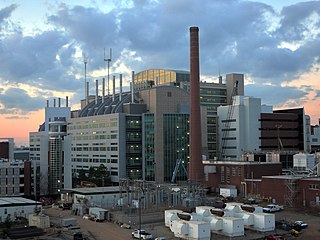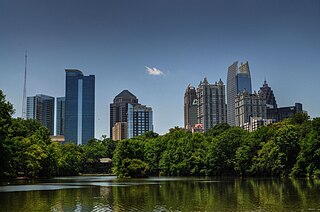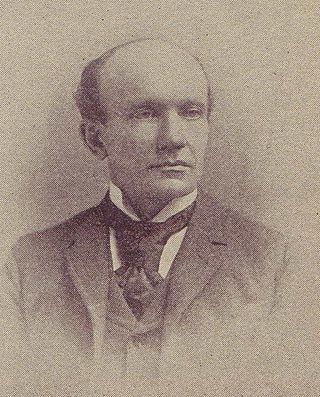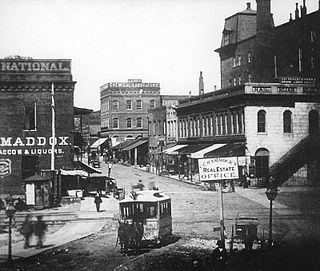
Druid Hills is a community which includes both a census-designated place (CDP) in unincorporated DeKalb County, Georgia, United States, as well as a neighborhood of the city of Atlanta. The CDP's population was 14,568 at the 2010 census. The CDP formerly contained the main campus of Emory University and the Centers for Disease Control and Prevention (CDC) however they were annexed by Atlanta in 2018. The Atlanta-city section of Druid Hills is one of Atlanta's most affluent neighborhoods with a mean household income in excess of $238,500.

Midtown Atlanta, or Midtown, is a high-density commercial and residential neighborhood of Atlanta, Georgia. The exact geographical extent of the area is ill-defined due to differing definitions used by the city, residents, and local business groups. However, the commercial core of the area is anchored by a series of high-rise office buildings, condominiums, hotels, and high-end retail along Peachtree Street between North Avenue and 17th Street. Midtown, situated between Downtown to the south and Buckhead to the north, is the second-largest business district in Metro Atlanta. In 2011, Midtown had a resident population of 41,681 and a business population of 81,418.
There were several historic mills around the metro Atlanta area, for which many of its current-day roads are still named. Most of the mills date back to the 1820s and 1830s, and were built along the area's many streams. The locations of many of these mills are shown on a map of 1875 showing U. S. military operations around Atlanta in 1864. This map is now located in the U. S. Library of Congress but can be seen on the webpage linked here.
From its incorporation in 1847, the municipal boundaries of Atlanta, Georgia, United States, were extended repeatedly from a small area around its railroad station to today's city covering 131.7 square miles (341 km2).

Cascade Heights is an affluent neighborhood in southwest Atlanta. It is bisected by Cascade Road, which was known as the Sandtown Road in the nineteenth century. The road follows the path of the ancient Sandtown Trail which ran from Stone Mountain to the Creek village of Sandtown on the Chattahoochee River and from there on into Alabama. Ironically, the name lived on even after the Indians were expelled in the 1830s.

Five Points is a metro station of the Metropolitan Atlanta Rapid Transit Authority (MARTA) rail system in Atlanta, Georgia. It is the transfer point for all rail lines and serves as the main transportation hub for MARTA. It provides access to the Five Points Business District, Georgia State University, Underground Atlanta, City Hall, the Richard B. Russell Federal Building, CobbLinc, Ride Gwinnett, GRTA Xpress Transit, Station Soccer, and the tourism heart of Downtown Atlanta. It provides connecting bus service to Zoo Atlanta, Grant Park, Atlanta University Center, East Atlanta Village, Martin Luther King Jr. National Historical Park, Carter Center, Atlanta City Hall, South Dekalb Mall and Fulton County Government Center.

Joseph Neel Reid, also referred to as Neel Reid, was a prominent architect in Atlanta, Georgia, in the early 20th century as a partner in his firm Hentz, Reid and Adler.

Sylvan Hills is a historic intown neighborhood in southwest Atlanta, Georgia, United States.

Perkerson Park is a 50-acre (200,000 m2) park in the Capitol View/Sylvan Hills neighborhoods of Atlanta, Georgia with many offerings such as disc golf, tennis courts, splash pads, an elaborate playground, recreational fields, all under the shady canopy of huge oak trees. The park is open 6:00 AM to 11:00 PM daily.

Godfrey Leonard Norrman, was an important architect in the southeastern United States. A number of his commissions are now listed on the National Register of Historic Places, and in 1897 he was made a Fellow of the American Institute of Architects.
The Perkerson neighbourhood is located in Southwest Atlanta, Georgia, in NPU-X. The name change was made at the request of residents and members of the Perkerson Civic Association (PCA) in order to keep people from confusing the neighbourhood with Perkerson Park, which is the large park that serves the area.
Chelsea Heights and Westchester Hills are adjacent neighborhoods, separated by a municipal park, in the northwest corner of the Atlanta, Georgia suburb of Decatur. Chelsea Heights straddles the east and west sides of the CSX railroad tracks, falling within the City of Decatur and the unincorporated DeKalb County, respectively. The latter part, though located east of what historically was Druid Hills, is part of the Druid Hills CDP and participates in the Druid Hills Civic Association: see Chelsea Heights.

Streetcars originally operated in Atlanta downtown and into the surrounding areas from 1871 until the final line's closure in 1949.
Albert Anthony Ten Eyck Brown (1878–1940) was an architect active in Atlanta, Georgia and other areas. Brown was born in Albany, New York. He studied at the New York Academy of Design.

Roy Blass was an American architect whose work included design of Lustron houses.

Willis F. Denny (1874-1905) was an architect active in Atlanta, Georgia around the turn of the twentieth century. He was the architect of Rhodes Hall (1903) and the Kriegshaber House, both listed on the National Register, as well as the demolished Piedmont Hotel (1903).

Walter T. Downing (1865-1918) was an American architect in Atlanta, Georgia. Several of his works are listed on the National Register of Historic Places.

The Solomon Goodwin House was located at 3931 Peachtree Road in Brookhaven, Georgia, 0.5 miles (0.80 km) east of Atlanta city limits. Dating back to 1831, it was the oldest building still standing in DeKalb County, Georgia and the oldest building "Inside the Perimeter". The home once headed up a 600-acre (240 ha) farm.

Utoy Cemetery is one of the oldest cemeteries within the current city limits of Atlanta in the U.S. state of Georgia and is listed on the National Register of Historic Places. Located near the intersection of Venetian Drive SW and Cahaba Drive SW in the Venetian Hills neighborhood in southwest Atlanta, it was used for burials as early as 1828.



















